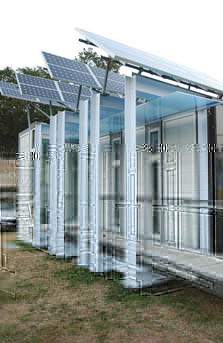

The main entrance to the Virginia Polytechnic Institute and State University house reflects the integration of form and function; productive energy technologies are engineered to create a welcoming space.
(Credit: Chris Gunn, Solar Decathlon)
Solar Decathlon 2005
New and Customized Technologies Features at Decathlon
This year's Solar Decathlon competition features a number of both new and customized energy-producing and energy-efficient technologies. They include a customized "solar chimney," a fuel cell energized by solar-produced hydrogen, an energy recovery ventilator, and two new kinds of structural insulated wall panels.
The solar chimney concept is based on the simple principle that warm air, being less dense than cooler air, rises. In some solar chimney designs, warm air moves up a very tall, narrow tower through a turbine to generate electricity. The University of Michigan team decided to adapt a much smaller version to provide passive solar heating and cooling to its Solar Decathlon home. In this solar chimney, sunlight heats the air in glass spaces at the base of the home's south wall. The heated air then rises along the curve of the roof and is either directed into the house by means of specially placed louvers for heating in winter, or released outside to cool the home in summer. The layer of air in the chimney provides convective and radiant heating control and added insulation.
The Solar Decathlon team from the New York Institute of Technology has also customized some solar and renewable energy technologies for its competition home. The team uses some of the electricity generated by its roof-mounted PV system to separate the hydrogen and oxygen in water through a process known as "electrolysis." The hydrogen is then stored and used later to power a fuel cell that produces electricity and heat on demand. Fuel cells, like batteries, convert the energy produced by a chemical reaction into usable electric power. But a fuel cell provides electricity as long as its fuel (hydrogen) is supplied and never loses its charge.
The Solar Decathlon team from Cornell University has customized an energy recovery ventilator (ERV) to provide heating and cooling to its competition home. This ERV houses a silica gel wheel, also known as a desiccant dehumidifier, which transfers heat and humidity between the home's intake and exhaust airstreams. The Cornell team's ERV is coupled with an electric heat pump and an air handler. A fully automatic computerized control system is able to operate the ERV as well as the rest of the heating and cooling system. But a touch screen allows for manual overrides, as needed.
To increase the energy efficiency of its competition home, the Washington State University team is showcasing a new type of structural insulated panel (SIP) designed by an architect in Spokane. This panel is the inverse of a traditional or foam-core panel, in which a facing is glued on both sides of a foam core. The most common facing materials are oriented strand board and plywood. In Washington State's SIP, a corrugated steel frame is encased by polystyrene material. This innovation allows electrical wiring and plumbing to be run through the SIP without compromising its structural integrity.
The University of Colorado's Solar Decathlon entry also features a unique "take" on the traditional SIP. For the walls, the team combined two off-the-shelf green building components into one newly patented SIP. The Colorado team's "BIO-SIP" is like a giant ice cream sandwich made of two panels of Sonoboard—a strong but lightweight board made of recycled materials by Sonoco Company—that are filled with BioBase 501—a lightweight foam insulation made from soybean oil by BioBased Systems.
Some day, many of these technologies could be as commonplace in the home-building industry as today's energy-efficient double-pane windows and attic fans. And credit for that can rightly go to the Solar Decathlon's many resourceful students, advisors, and sponsors.
